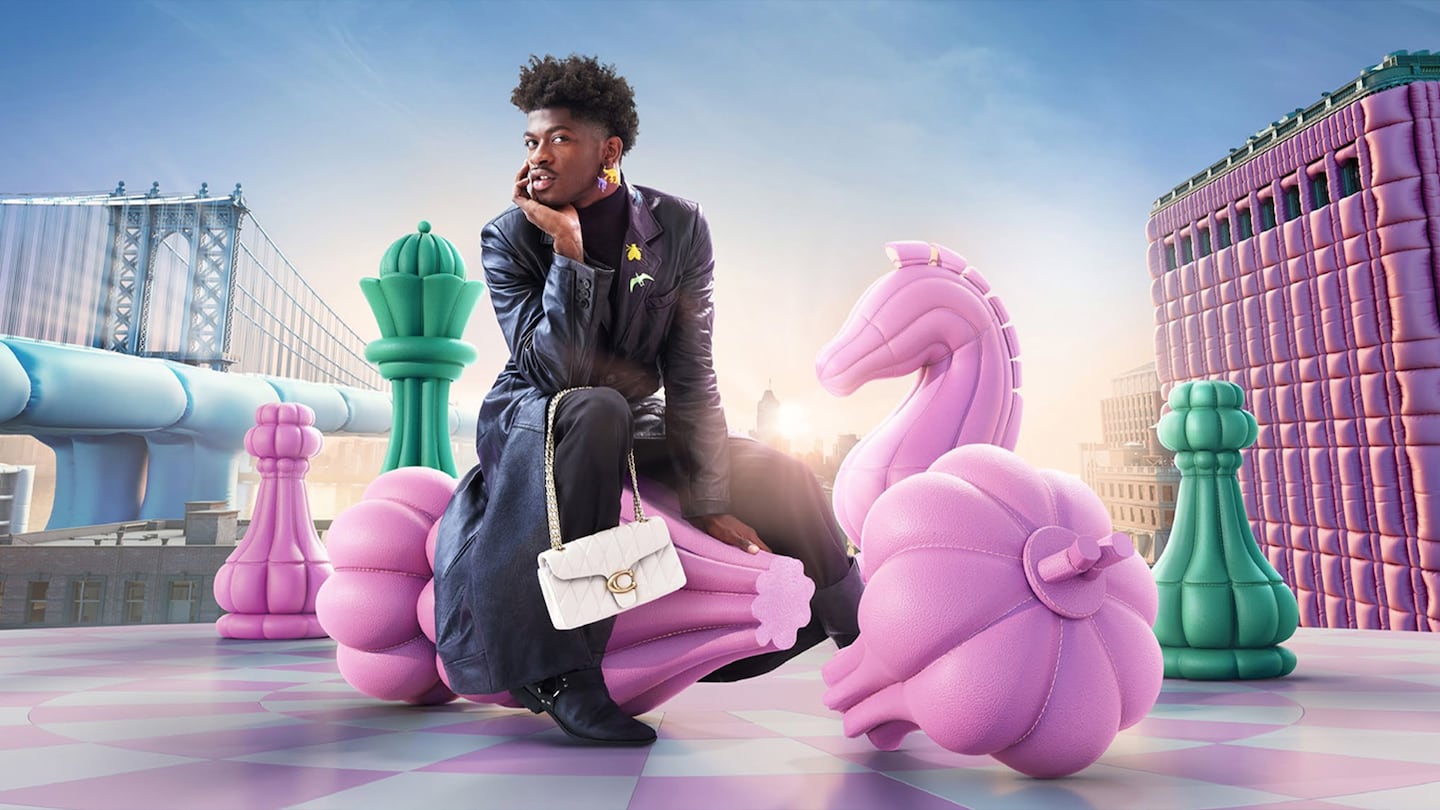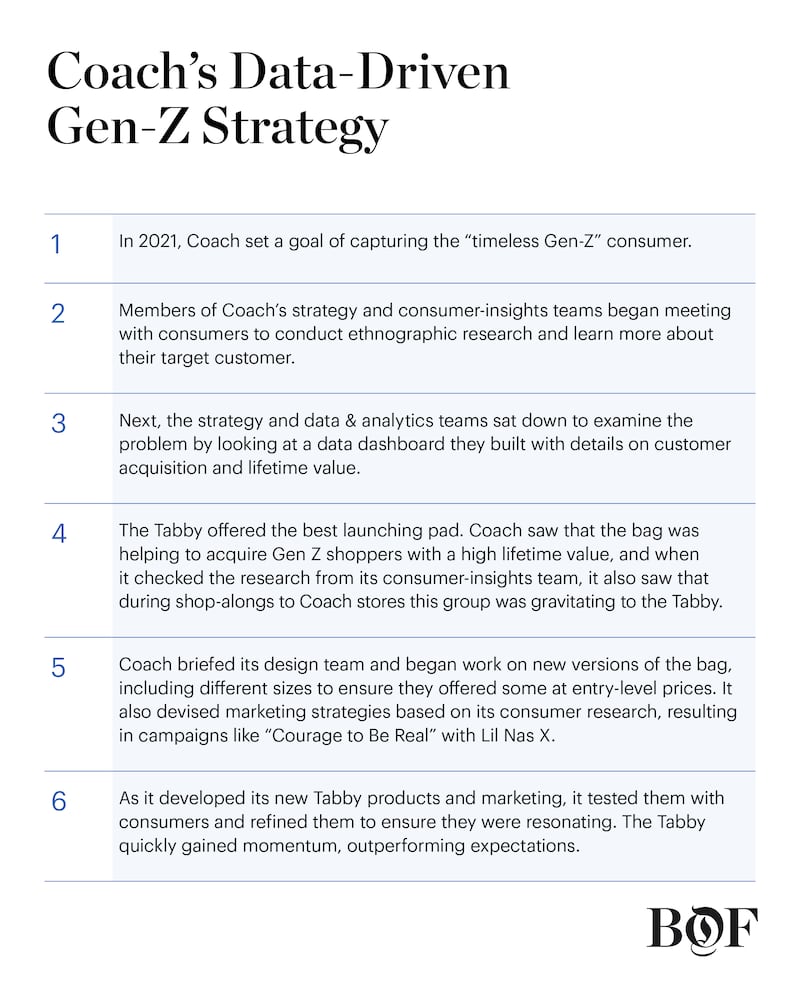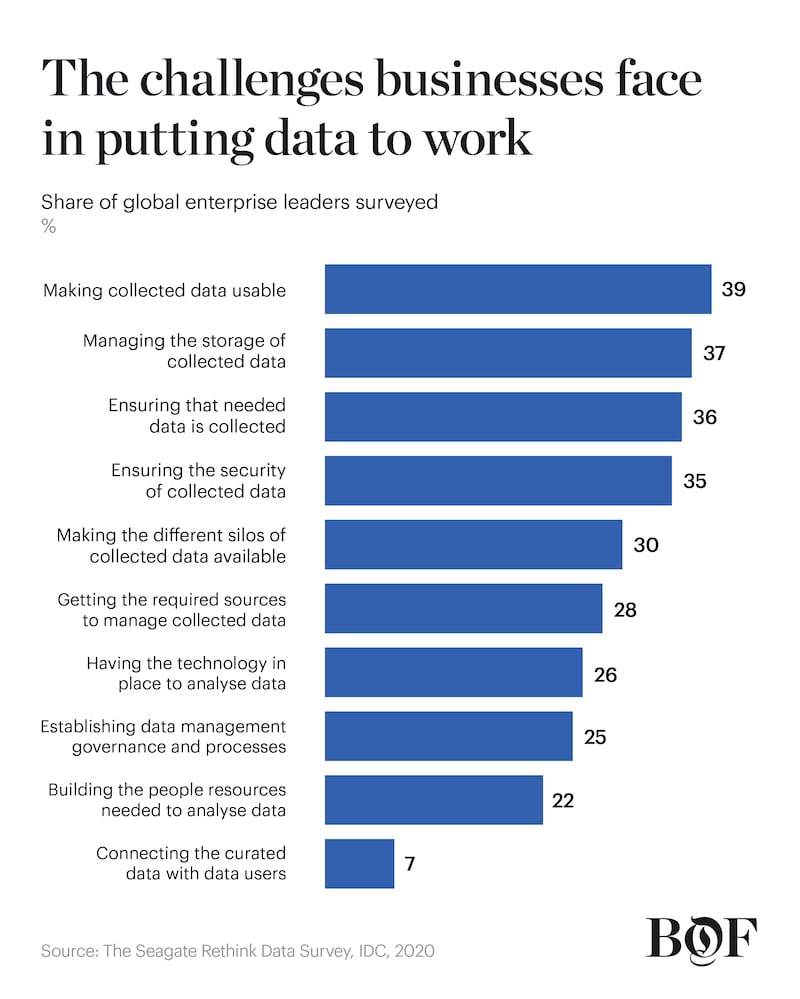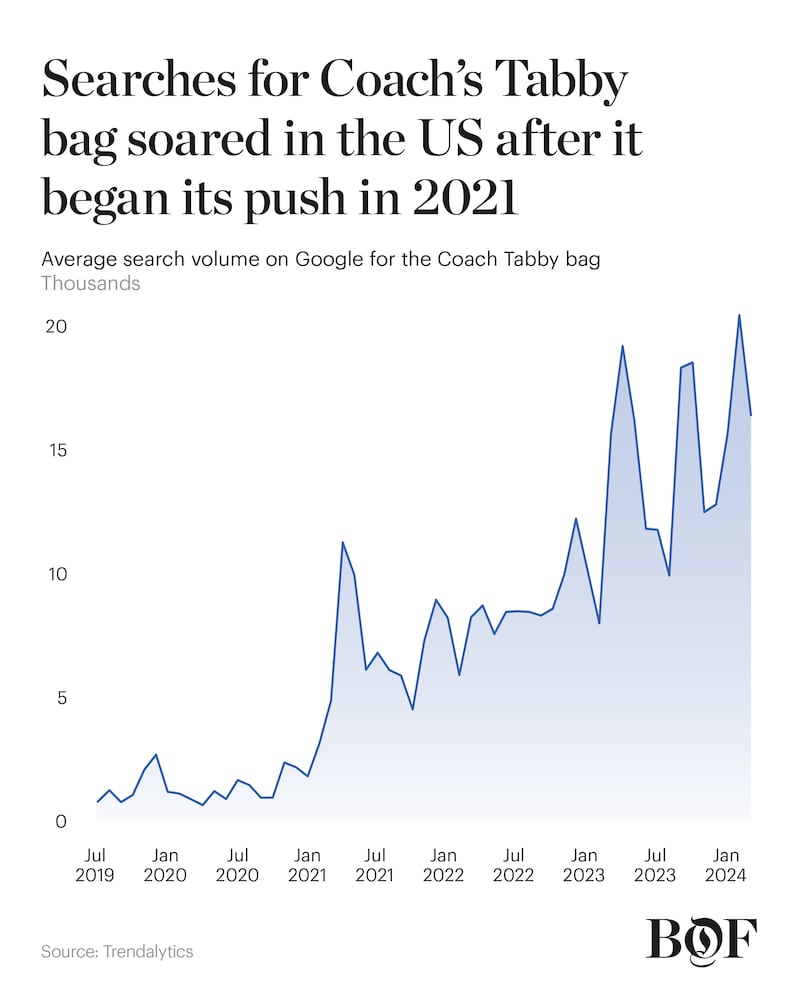
The Business of Fashion
Agenda-setting intelligence, analysis and advice for the global fashion community.

Agenda-setting intelligence, analysis and advice for the global fashion community.

Gen-Z didn’t fall for Coach by accident.
In 2021, Coach had set a strategic goal of appealing to what it dubbed a “timeless Gen-Z” customer. The company did some consumer segmentation and realised this was a shopper with classic style, who would invest in purchases and whom Coach felt it could win over.
But Coach needed to figure out how to reach them. Not long ago, consumers perceived it as an older label — “more of a mother’s brand,” Alice Yu, Tapestry’s vice president of global consumer insights stated bluntly. Coach had been revamping its image, but public perception can be slow to change.
Coach started meeting with shoppers to learn more about its target customer, and then Jennifer Yue, vice president of Coach strategy, sat down with Fabio Luzzi, head of data and analytics at Tapestry to work out a plan. Using a dashboard the data team had built, they saw the Tabby was bringing in lots of young shoppers who then went on to have a high lifetime value for the brand. The style, characterised by its front flap, which had an extended tab at the bottom secured by a C-shaped clasp, first came out in 2019, as accessible luxury in the US was losing ground to higher-end European rivals. The hardware and classic design, inspired by an archival Coach style from the 1970s, appealed to the Gen-Z shoppers the brand wanted to attract.
ADVERTISEMENT
They needed more validation, though. Their consumer research had also discovered through shop-alongs to Coach stores that these shoppers often gravitated to the Tabby, even as they remained ambivalent about the Coach brand overall.
“We can really create a franchise with this, and this can truly become an icon,” Yue said, reflecting back. “It really impacted what we started to do in terms of product development.”

They briefed the design team and started to release new iterations of the bag, including different sizes to ensure they offered some at entry-level prices. They also began to devise strategies to centre the bag as a hero product in their marketing. They leaned into the insight from Yu’s team that this Gen-Z group was seeking ways to feel more confident. In 2022, Coach featured the bag prominently on the runway and launched its “Courage to Be Real” campaign with Lil Nas X. It followed up in 2023 with the “In My Tabby” and “Wear Your Shine” campaigns and continued introducing new Tabby varieties like a quilted version. All the while they kept testing and refining to make sure the product and messaging were resonating.
The Tabby quickly gathered momentum. Average weekly searches for the bag in the US started to increase in 2021 and surged 368 percent in 2022, according to data from Trendalytics, a retail intelligence platform. Search volume continued to rise through 2023, albeit at a more moderate pace. Trendalytics also found that global engagement around the Tabby on Instagram, TikTok, Facebook and Pinterest spiked with each campaign. The biggest surge came in April 2023, amid a pop-up tour Coach was staging around the bag and a campaign with Jennifer Lopez that featured the Tabby.
On earning calls, CEO Crevoiserat has repeatedly touted the Tabby’s success noting in February 2024 that it outperformed expectations, “nearly doubling versus last year and over-indexing with new and younger consumers at above-average [selling price].”

The strategy may also be bolstering young shoppers’ overall impressions of Coach bags. In the first half of 2021, Coach was ranked the fourth favourite handbag brand among US female teens in the semiannual “Taking Stock With Teens” report from investment bank Piper Sandler. By the first half of 2022, it had risen to number one, a position it maintained through the end of 2023, with the share naming it their favourite brand rising.
Yue said the data dashboards have allowed them to understand what really works to acquire that timeless Gen-Z target consumer. They can slice data in terms of price point, style or SKU count in different channels. In her nearly decade at the company, including six years in global merchandising, she’s seen teams such as merchandising and design start to routinely bring data into the mix at the earliest stages of a project. It’s yielded benefits such as higher conversion rates and higher average selling prices.
ADVERTISEMENT

“We’ve done much better over the last few years to identify the areas that are really going to impact our business,” Yue said. “Some of those historically may not have focused as intently on the consumer, but they are much more now embedded in there, along with many of the sales goals that we have. I do think that has made a meaningful impact.”
There can be instances in which people aren’t convinced by the data right away, where the art and science — or magic and logic, in Tapestry’s preferred terminology — clash. One older team member was doubtful of the commercial potential for Coach’s Swing Zip bag, an archival style, among Gen-Z, according to Yue. But in their testing, they found the group loved it.
The goal, though, isn’t for data to overrule everything else. It’s to give decision-makers more information and a stronger foundation from which to choose a course of action.

“We’re in fashion, so there are some things where the art elements are really important,” Paransky said. “Then data gets created and some of those elements for a particular product or campaign become less art, because we get the data so we have more certainty about what’s happening or not happening.”
If you want to read more about how to turn data into meaningful customer connections, download the case study here.
A Coach restaurant and coffee shop will open on March 4 next to one of the brand’s stores in the Indonesian capital.
Creative director Stuart Vevers, who is celebrating a decade with the brand, brought apparel to Coach and has quietly built it into a nearly $740 million a year business.
The American accessories giant says the line will serve as lab to develop new design and production models, starting with a capsule that features patchworked products made from manufacturing scraps. How the project will scale remains unclear.

Marc Bain is Technology Correspondent at The Business of Fashion. He is based in New York and drives BoF’s coverage of technology and innovation, from start-ups to Big Tech.
BoF Careers provides essential sector insights for fashion's technology and e-commerce professionals this month, to help you decode fashion’s commercial and creative landscape.
The algorithms TikTok relies on for its operations are deemed core to ByteDance overall operations, which would make a sale of the app with algorithms highly unlikely.
The app, owned by TikTok parent company ByteDance, has been promising to help emerging US labels get started selling in China at the same time that TikTok stares down a ban by the US for its ties to China.
Zero10 offers digital solutions through AR mirrors, leveraged in-store and in window displays, to brands like Tommy Hilfiger and Coach. Co-founder and CEO George Yashin discusses the latest advancements in AR and how fashion companies can leverage the technology to boost consumer experiences via retail touchpoints and brand experiences.